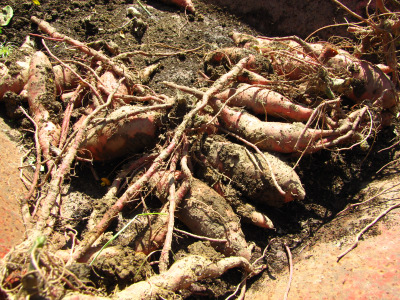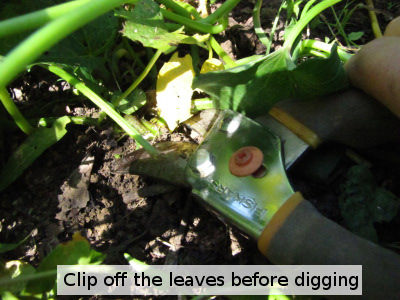
Sweet potato harvest
 I
went out to dig the other 20% of the sweet potatoes Tuesday morning and
came home with this measly wheelbarrow full. And for the rest of
the day, I pondered why Monday's
beds yielded up dozens of mammoth tubers while Tuesday's beds gave me
just a few skinny roots.
I
went out to dig the other 20% of the sweet potatoes Tuesday morning and
came home with this measly wheelbarrow full. And for the rest of
the day, I pondered why Monday's
beds yielded up dozens of mammoth tubers while Tuesday's beds gave me
just a few skinny roots.
I considered planting
date, since I put in a bed every week or so between mid May and late
June, but my measly beds were planted near the beginning of that
succession and even the latest-planted bed yielded up good-sized
tubers. Or maybe it was the type of fertilizer? Nope, I
gave all of our sweet potatoes the same chicken
manure compost.
 I
had just read Steve
Solomon's Gardening When it Counts when planting our sweet
potatoes this year, so I spaced the slips nearly twice as far apart as
last year (only four slips in an average sized bed.) That
planting method might explain why I had so many huge tubers, but since
I used the same method on the measly beds, it doesn't explain the
disproportionate yield between beds.
I
had just read Steve
Solomon's Gardening When it Counts when planting our sweet
potatoes this year, so I spaced the slips nearly twice as far apart as
last year (only four slips in an average sized bed.) That
planting method might explain why I had so many huge tubers, but since
I used the same method on the measly beds, it doesn't explain the
disproportionate yield between beds.
Finally, the simplest
answer came to me --- location. All of my hefty tubers came from
the upper garden where we enjoy a slightly clayey loam, while the
measly tubers came from the mule garden which is pure clay. I was
tricked into thinking the mule garden would be  okay
for sweet potatoes since I've had good harvests from garlic, white
potatoes, and carrots there, but my failure with onions in the mule
garden clay and with all of the above in the back garden's even more
clayey clay should have clued me in --- root crops just don't like
clay. Next year, I'll stick to the front garden for our sweet
potatoes.
okay
for sweet potatoes since I've had good harvests from garlic, white
potatoes, and carrots there, but my failure with onions in the mule
garden clay and with all of the above in the back garden's even more
clayey clay should have clued me in --- root crops just don't like
clay. Next year, I'll stick to the front garden for our sweet
potatoes.
Check out my previous
posts to learn more about when
to harvest sweet potatoes and how to
cure sweet potatoes.
Or, if you're really into planning ahead for next year, learn to
make your own sweet potato slips!
Want more in-depth information? Browse through our books.
Or explore more posts by date or by subject.
About us: Anna Hess and Mark Hamilton spent over a decade living self-sufficiently in the mountains of Virginia before moving north to start over from scratch in the foothills of Ohio. They've experimented with permaculture, no-till gardening, trailersteading, home-based microbusinesses and much more, writing about their adventures in both blogs and books.
Want to be notified when new comments are posted on this page? Click on the RSS button after you add a comment to subscribe to the comment feed, or simply check the box beside "email replies to me" while writing your comment.
- Remove comment
- Remove comment
